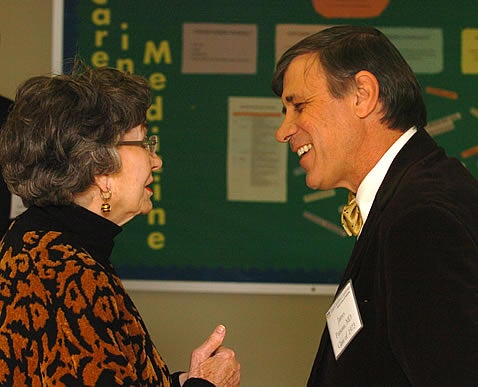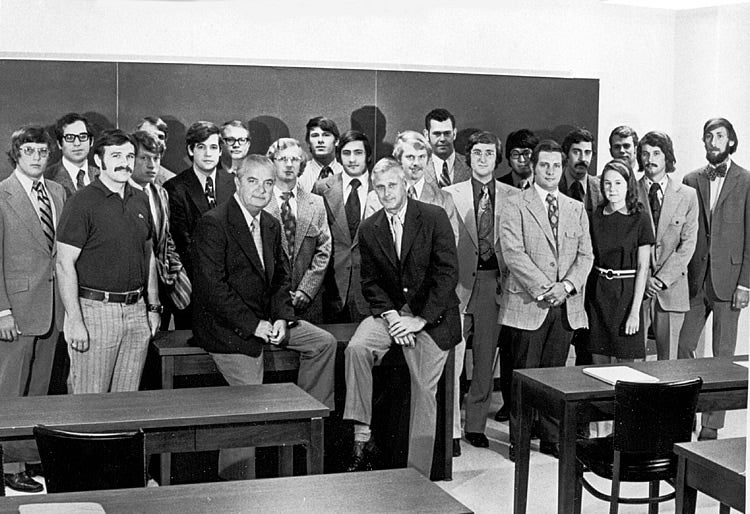‘UNDER A MICROSCOPE’
Inaugural medical class honored
In 1972, when he and his classmates made up the first group of East Carolina University medical students, Dr. Douglas Privette said they knew they had to excel.
“We worked very hard,” he said. “We basically studied just about continuously, except maybe Friday and Saturday night. We had regular tests. You were forced to keep up.”
 Privette was one of 20 in the program, after which students transferred to the University of North Carolina at Chapel Hill. It was the first step toward ECU having its own medical school.
Privette was one of 20 in the program, after which students transferred to the University of North Carolina at Chapel Hill. It was the first step toward ECU having its own medical school.
“We knew we were sort of under a microscope, under the gun to make sure we weren’t behind when we got to UNC,” he said.
The program helped fulfill the vision of Dr. Leo Jenkins, president of what was then East Carolina College, to build a medical school in Greenville. The first class is being honored this weekend by the ECU Medical and Health Sciences Foundation.
In 1965, a year after Jenkins began his campaign for a medical school, the North Carolina General Assembly authorized East Carolina to establish a school and provided planning funds for its development.
‘An exciting time’
The first ECU medical faculty members started work in 1970, under the leadership of Dr. Wallace Wooles, a pharmacologist and the first dean. The following year, the General Assembly appropriated operating funds to allow enrollment in the one-year program.
In 1972, those first 20 students arrived, followed by two more classes of 20 each, all North Carolinians, in 1973 and 1974.
“Oh, what an exciting time to be starting a medical school,” said Dr. Lynis Dohm, one of the original ECU medical faculty members who still works as a diabetes researcher at the school. “The first-year class was just excited to be here. They were all good students and worked hard.”
Dr. Hubert Burden, a professor of anatomy and another original faculty member, described the one-year program as a compromise, a chance for ECU to show it could operate a successful medical school.
“Considering the politics of those days, I think it was important for our people to go to Chapel Hill and show they were just as good as any recruited at Chapel Hill and better in many cases,” said Burden, who still teaches part-time. “Everybody was under the microscope, and I think everyone passed the test.”
Starting small
Classes were held on main campus in Room S109 of what is now the Howell Science Complex, a room specially refurbished for the medical students. Burden taught anatomy in a double-wide trailer near Christenbury Gym. He doubts passersby knew that inside students were cutting and examining cadavers.
“For the most part I don’t think so, and it’s probably better that they didn’t,” he said with a laugh.
The thinking in Greenville, Raleigh and at the UNC General Administration offices in Chapel Hill was that ECU would grow to a two-year program, with expansion to a full four-year program later.
But in late 1974, plans changed. The next year, upon recommendation of the UNC Board of Governors, the General Assembly appropriated $43 million for initial construction of facilities and implementation of a four-year medical school at ECU. The charter class of 28 students enrolled in 1977. The school received full accreditation in February 1981, and the first class graduated that spring.
Today, the Brody School of Medicine at ECU enrolls 80 students with each class.

Dr. Evelyn McNeill, left, an original ECU medical faculty member, talks with Dr. James Parsons, a member of the first one-year medical class, during a gathering Nov. 8 at the Brody Medical Sciences Building. (Photo by Doug Boyd)
The right place
Privette retired from patient care in 2008 and now works as an administrator with the East Carolina Heart Institute at Vidant Medical Center. He’s also a board member of the ECU medical foundation.
“The opportunity to go to medical school was something I was excited about but knew I didn’t have the GPA or MCAT to get into UNC or Bowman-Gray,” he recalled. “They basically gave us a chance to go to medical school.”
The son of a Baptist minister from Havelock with a biology degree from ECU, Privette fit the demographic East Carolina was aiming for: North Carolinians who wanted to stay in the state, preferably in the region, to practice. He and his classmates knew they had to do their best to make the school successful.
Once in Chapel Hill, however, they experienced a different, learn-at-your-own-pace environment.
“All of a sudden, we didn’t have weekly exams,” he said. Instead, students were given self-instruction packets to study on their own if they preferred. “It was so much more relaxing.”
After completing medical school and a residency at N.C. Memorial Hospital, Privette completed a fellowship in cardiology at Vanderbilt University in Tennessee, then returned to Greenville to open his practice.
For the first few years, he also served as an ECU clinical assistant professor, with students rotating through his practice for a month at a time.
Privette said he, probably like most graduates of UNC, is proud of his medical alma mater. But ECU holds a special place, too. (His daughter and son-in-law have medical degrees from ECU.)
“We are lucky we got into medical school,” he said. “We were lucky ECU was starting its medical school the year we were starting. If ECU had not had its medical school, it’s conceivable I would not be a physician now. All 20 members of the class feel the same way. We were at the right place at the right time.”
Today, the class members have spread north to Ohio, south to Florida and west to the Rocky Mountains and have impressive accomplishments. For example, Dr. Sheldon Michael Retchin is a national expert in health policy and health care delivery, senior vice president for health sciences at Virginia Commonwealth University Health System and chief executive of the VCU Health System.
“It is just fascinating to be here at a time when the school has clearly come into its own, and the earliest graduates are displaying all of the high qualities of the profession, in leadership and service, that were imagined so many years ago,” said Dr. Paul Cunningham, dean of the medical school.
###
The ECU Medical & Health Sciences Foundation honored Dr. Douglas Privette with this year’s Distinguished Alumni Award winner, and Dr. Amy Howell of the Class of 2006 is the Katherine Bray-Strickland Young Alumni Award recipient for this year.
